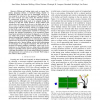Free Online Productivity Tools
i2Speak
i2Symbol
i2OCR
iTex2Img
iWeb2Print
iWeb2Shot
i2Type
iPdf2Split
iPdf2Merge
i2Bopomofo
i2Arabic
i2Style
i2Image
i2PDF
iLatex2Rtf
Sci2ools
ICRA
2010
IEEE
2010
IEEE
Movement templates for learning of hitting and batting
Abstract— Hitting and batting tasks, such as tennis forehands, ping-pong strokes, or baseball batting, depend on predictions where the ball can be intercepted and how it can properly be returned to the opponent. These predictions get more accurate over time, hence the behaviors need to be continuously modified. As a result, movement templates with a learned global shape need to be adapted during the execution so that the racket reaches a target position and velocity that will return the ball over to the other side of the net or court. It requires altering learned movements to hit a varying target with the necessary velocity at a specific instant in time. Such a task cannot be incorporated straightforwardly in most movement representations suitable for learning. For example, the standard formulation of the dynamical system based motor primitives (introduced by Ijspeert et al. [1]) does not satisfy this property despite their flexibility which has allowed learning tasks ranging from...
Ball | ICRA 2010 | Necessary Velocity | Robotics | Velocity |
| Added | 26 Jan 2011 |
| Updated | 26 Jan 2011 |
| Type | Journal |
| Year | 2010 |
| Where | ICRA |
| Authors | Jens Kober, Katharina Mülling, Oliver Kroemer, Christoph H. Lampert, Bernhard Schölkopf, Jan Peters |
Comments (0)

